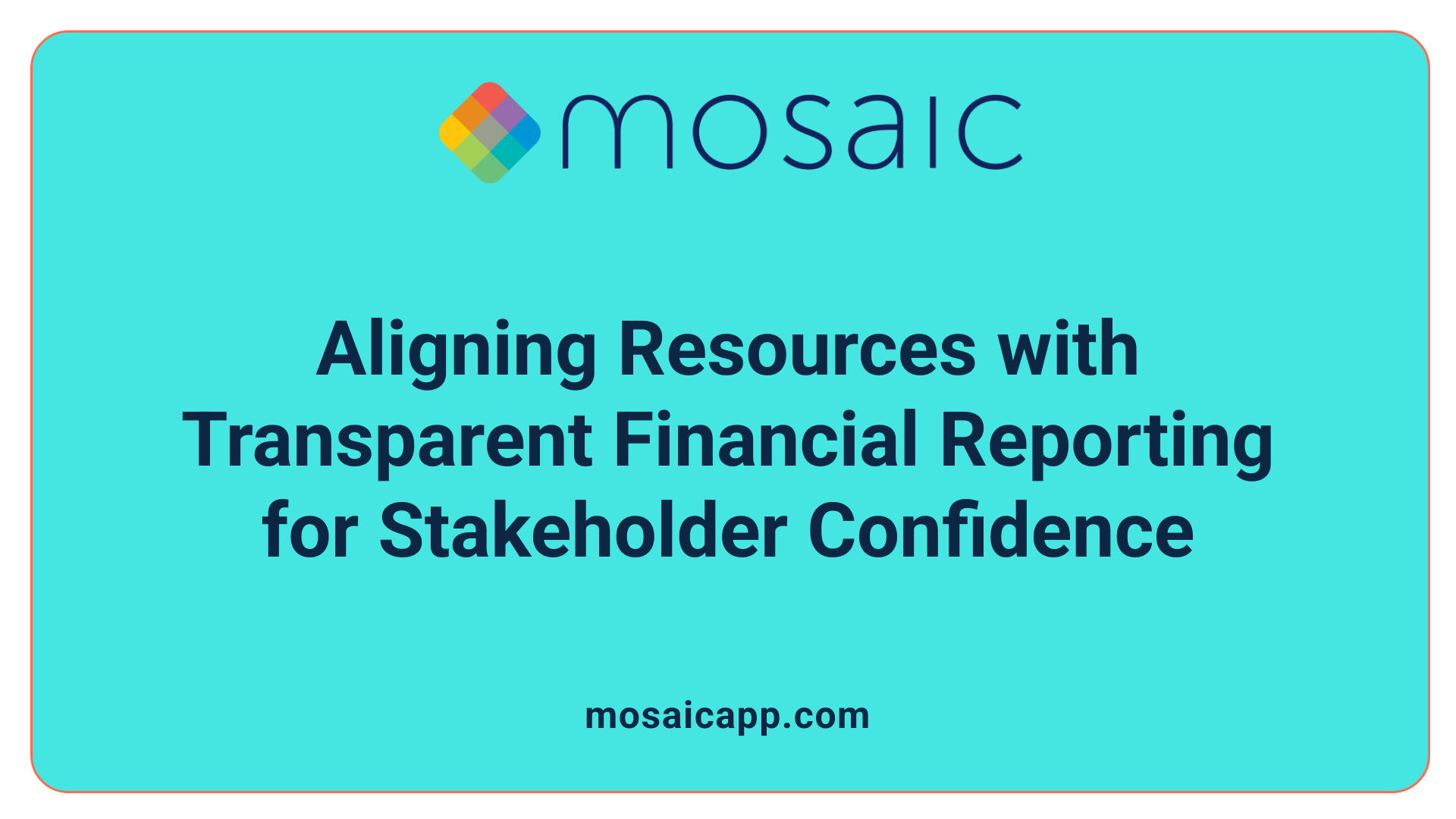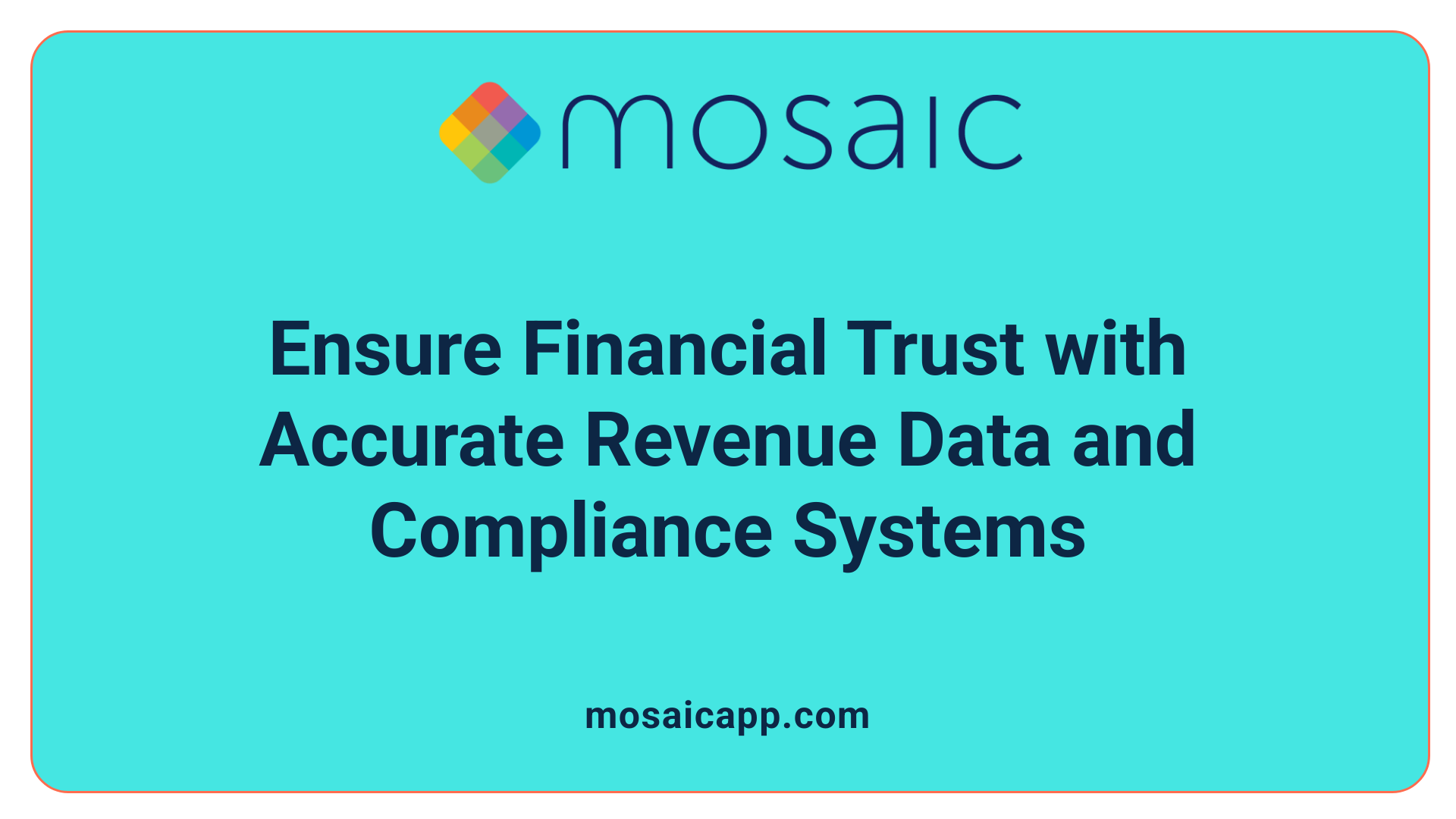The Power of Resource Management in Cultivating Investor Loyalty
Effective resource management is fundamental to fostering investor confidence. Organizations that transparently oversee their assets, manage risks diligently, and communicate strategic intentions effectively can significantly enhance their credibility and attractiveness to investors. By integrating advanced tools, adhering to regulatory standards, and demonstrating sustainability commitments, companies can build a resilient reputation that encourages ongoing investment and stakeholder trust.
The Interplay Between Resource Management and Financial Transparency

How does resource management relate to financial reporting and revenue recognition?
Resource management plays a crucial role in ensuring accurate financial reporting and proper revenue recognition. By effectively allocating and maintaining assets, organizations can accurately record revenues and expenses, adhering to standards such as ASC 606 and IFRS 15. These standards require companies to recognize revenue when performance obligations are satisfied, which often depends on how resources are deployed and controlled.
When resources are properly managed, they support correct valuation of assets and timely expense recognition. This meticulous approach helps companies match revenues with related costs, ensuring financial statements reflect true business performance.
Poor resource management, on the other hand, can cause discrepancies or even manipulation of revenue data. Misallocation or neglect of assets can lead to errors in revenue timing or valuation, thus impairing transparency and eroding investor trust.
Integrating disciplined resource management practices is essential for compliance and maintaining the integrity of financial records. It not only enhances the accuracy of financial reports but also reinforces investor confidence by demonstrating reliable and transparent revenue recognition processes.
How does revenue recognition tie into resource deployment?
Revenue recognition depends heavily on the effective deployment of resources. When resources are aligned with contractual performance milestones, companies can better ensure that revenues are recognized in the correct accounting period. Proper resource deployment helps verify when control transfers and obligations are fulfilled, which is critical for compliance with accounting standards.
This alignment fosters a clearer understanding of revenue streams and supports better business decision-making. Additionally, accurate resource deployment minimizes the risk of revenue manipulation, safeguarding the organization’s reputation and investor relations.
What role do ERP systems play in standardizing financial data?
Enterprise Resource Planning (ERP) systems like Deskera are transforming financial data management by automating and standardizing revenue recognition processes. These systems facilitate consistent data collection across all business units, helping organizations comply with accounting standards and regulatory requirements.
ERP tools improve data accuracy by reducing manual errors and enable real-time insights into resource utilization and financial metrics. With features like automated revenue recognition and compliance checking, ERP systems help companies produce transparent, reliable financial reports.
Overall, the implementation of ERP solutions supports rigorous resource management and accurate financial reporting, strengthening investor confidence and promoting sustainable growth.
| Aspect | Impact | Additional Detail |
|---|---|---|
| Resource Management | Ensures asset allocation supports accurate revenue reporting | Properly maintained assets enable timely revenue recognition and compliance |
| Revenue Recognition | Tied to resource deployment and control transfer | Proper resource handling ensures correct timing and valuation of revenue |
| ERP Systems | Automate and standardize financial data | Improve accuracy, compliance, and transparency for confidence building |
Focusing on resource efficiency and robust technological tools helps companies foster transparency, boost investor trust, and sustain long-term growth.
Enhancing Profitability and Future-Proofing the Workforce

What are the benefits of forecasting and resource planning for demand anticipation?
Effective forecasting and resource planning play a crucial role in understanding future project needs. By predicting demand early, managers can make informed decisions about hiring, equipment procurement, and workload distribution. This proactive approach reduces unnecessary costs and minimizes resource wastage.
Forecasting also helps identify potential bottlenecks and skills gaps ahead of time. This readiness supports continuous project flow and prevents delays, enhancing overall profitability. Additionally, accurate demand anticipation ensures that resources are aligned with strategic goals, making the organization more adaptable to market changes.
How can analytics improve workload optimization?
Analytics provide real-time insights into resource utilization, helping managers balance workloads efficiently. Using data-driven heatmaps and dashboards, teams can evenly distribute tasks across available talent pools, avoiding overburdening some staff while under-utilizing others.
This approach maximizes the profitable use of resources, reduces idle time, and increases productivity. Furthermore, analytics enable continuous performance assessment, allowing leaders to make adjustments swiftly. As a result, organizations can maintain high levels of efficiency and deliver projects on time and within budget.
Why is training and upskilling essential during market volatility?
Market conditions can change rapidly, introducing new challenges and requiring new skills. Investing in employee training and upskilling is vital to keep the workforce agile and resilient.
Upskilling helps bridge skills gaps identified through resource forecasting and analytics, ensuring employees are prepared for evolving project demands. It also promotes workforce satisfaction and retention, reducing turnover costs.
In times of volatility, a well-trained team can adapt to changing workloads, adopt new technologies, and meet strategic objectives with confidence. This resilience sustains business stability and supports long-term growth.
| Strategy Area | Benefits | Tools/Methods | Additional Insights |
|---|---|---|---|
| Forecasting & Planning | Anticipates demand, reduces costs, prevents delays | Data analysis, trend forecasting | Early demand signals inform hiring and procurement decisions. |
| Analytics for Optimization | Maximizes utilization, boosts productivity | Real-time dashboards, heatmaps | Helps balance workloads and improve project delivery metrics. |
| Training & Upskilling | Enhances agility, manages market risks | Employee development programs | Keeps skills aligned with new industry standards and technologies. |
Strong resource management not only improves organizational efficiency but also enhances investor confidence. Transparency in planning, along with demonstrable commitment to workforce resilience, reassures stakeholders about the company's long-term sustainability and profitability. This approach ultimately contributes to a robust, adaptive, and high-performing organization.
Building Stakeholder Trust through Transparency and Communication

How can strategic resource optimization support transparency and build trust?
Strategic resource management plays a vital role in fostering transparency and strengthening stakeholder confidence. When companies optimize their resources effectively, they demonstrate accountability and a clear understanding of their operational strengths and challenges.
Adopting transparent strategies—whether they involve cautious or proactive resource allocation—signals to investors and stakeholders that the firm is committed to responsible management. For instance, allocating more resources to non-financial assets like plant and equipment shows confidence in the company’s long-term growth capabilities.
Empirical studies indicate that early and aggressive resource deployment can improve survival prospects and facilitate high growth rates. Such practices reflect a strategic mindset focused on sustainable development and trustworthy governance.
Clear communication about resource decisions—explaining why certain assets are prioritized—builds trust and reassures stakeholders about the company's future trajectory. When stakeholders understand the rationale behind resource utilization, they are more likely to perceive the company as transparent and reliable.
In summary, transparent, well-communicated resource strategies not only optimize operations but also serve as a foundation for trust. Consistent, responsible resource management aligns with stakeholders’ interests, boosting confidence in management’s ability to lead the company toward sustainable success.
ESG, Sustainability, and Transparency: Influencing Investor Perceptions

How do ESG, sustainability, and transparency initiatives shape investor views?
ESG (Environmental, Social, and Governance), sustainability efforts, and transparent reporting practices play a crucial role in shaping how investors perceive a company's stability and future potential. When companies actively showcase their commitment to responsible practices, they position themselves as forward-thinking and resilient.
High disclosure scores and adherence to globally recognized reporting frameworks such as GRI, SASB, and TCFD elevate a company's credibility. These standards ensure that ESG data is consistent and comparable, facilitating informed decision-making for investors.
Investors increasingly see strong ESG performance as a marker of lower risks and adaptive agility. A company that demonstrates clear sustainability goals and transparent practices signals an ability to navigate regulatory environments, market shifts, and stakeholder expectations effectively.
Comprehensive sustainability reports provide insights into a firm's environmental impact, social responsibility, and governance quality. Such transparency influences investor perceptions by highlighting long-term value creation and risk mitigation.
Furthermore, active engagement with stakeholders and effective investor relations foster trust and open communication channels, reinforcing positive views of the company's strategic direction and ethical commitments.
Announcing Accurate Revenue Figures and Compliance Enhancements
 Accurate revenue reporting plays a crucial role in building and maintaining investor confidence. When companies deliver precise and transparent revenue figures, stakeholders can better assess financial health, growth prospects, and potential risks. This transparency not only fosters trust but also aligns with regulatory expectations, helping organizations stay compliant with standards such as Generally Accepted Accounting Principles (GAAP) and International Financial Reporting Standards (IFRS). These frameworks emphasize the importance of truthful revenue recognition, which supports fair presentation of financial statements.
Accurate revenue reporting plays a crucial role in building and maintaining investor confidence. When companies deliver precise and transparent revenue figures, stakeholders can better assess financial health, growth prospects, and potential risks. This transparency not only fosters trust but also aligns with regulatory expectations, helping organizations stay compliant with standards such as Generally Accepted Accounting Principles (GAAP) and International Financial Reporting Standards (IFRS). These frameworks emphasize the importance of truthful revenue recognition, which supports fair presentation of financial statements.
To achieve this, many companies are turning to advanced Enterprise Resource Planning (ERP) systems like Deskera. These tools automate and standardize revenue recognition processes, reducing the likelihood of errors and ensuring adherence to complex rules such as ASC 606 and IFRS 15. ERP solutions facilitate real-time data collection, streamline compliance management, and enhance transparency, ultimately bolstering investor confidence.
How does resource management relate to financial reporting and revenue recognition?
Effective resource management directly impacts financial reporting by ensuring that assets and personnel are optimally allocated and utilized. Proper resource oversight supports the accurate timing and measurement of revenues, aligning with standards that require recognizing revenue when performance obligations are satisfied. Well-managed resources help prevent discrepancies and manipulations in financial data, making the revenue figures more reliable.
Integrating diligent resource management practices with financial reporting processes ensures companies can maintain compliance, present trustworthy revenue data, and uphold their credibility with investors. This synergy is vital for sustainable business growth and long-term investor trust.
For further insights into best practices, search for "Revenue recognition and resource management best practices."
The Role of Regulatory Policies and Industry Standards

How do regulatory policies and standards influence resource management and reporting practices?
Regulatory policies and standards play a critical role in shaping how companies manage their resources and disclose financial and non-financial information. They set mandatory requirements that organizations must follow, which helps promote transparency, accountability, and consistency.
For instance, regulations like ESG reporting mandates encourage firms to disclose their environmental and social impacts comprehensively. International standards such as GAAP and IFRS guide financial reporting, ensuring that revenue, expenses, and other key data are recorded accurately and uniformly. This standardization facilitates comparison across different companies and industries.
Industry-specific frameworks like GRI, SASB, and TCFD have been developed to help organizations report ESG issues in a structured way. These frameworks improve the quality and comparability of disclosures, which builds investor trust and confidence.
Regulatory compliance also reduces the risk of penalties and safeguards company reputation. When organizations adhere to these standards, they demonstrate responsible resource use and transparency, which are increasingly demanded by stakeholders.
In essence, these policies motivate companies to manage resources efficiently, report reliably, and align their operations with evolving market expectations. This fosters a sustainable business environment where resource utilization and disclosure practices serve both corporate interests and societal needs.
Sustainable Development and Resource Management for Long-term Confidence

How does resource management relate to financial reporting and revenue recognition?
Resource management plays a crucial role in ensuring accurate financial reporting and revenue recognition. Proper allocation, utilization, and maintenance of assets help companies meet standards like ASC 606 and IFRS 15, which focus on recognizing revenue based on the transfer of control and performance obligations. When resources—such as inventory, labor, or technology—are effectively managed, companies can accurately determine asset valuations and expenses, aligning revenue recognition with actual performance.
Effective resource management also supports precise valuation of resources involved in generating revenue, which is essential for reliable financial statements. Conversely, mismanagement can lead to inaccuracies, errors, or even fraudulent reporting, damaging stakeholder trust. Therefore, integrating comprehensive resource management practices is vital for compliance, transparency, and sustaining investor confidence.
Beyond compliance, strategic resource oversight enables businesses to optimize operations, reduce costs, and enhance profitability. Companies that manage their resources well can adapt swiftly to market changes, ensuring consistent revenue flow and financial stability.
In summary, resource management directly influences how companies report revenues and expenses, solidifying their credibility and building long-term trust with investors and regulators.
Fostering Investor Confidence through Strategic Resource Oversight
In an increasingly complex and transparent investment environment, organizations that prioritize strategic resource management—integrating comprehensive risk assessments, ESG commitments, accurate financial reporting, and proactive stakeholder communication—set themselves apart as trustworthy and resilient. These practices not only mitigate risks and demonstrate operational competence but also build a credible narrative that resonates with investors seeking stability and long-term value. Embracing best practices in resource management is a strategic imperative for companies aiming to strengthen investor confidence and ensure sustainable growth in the modern marketplace.
References
- With an ocean of resources, investors are surfing their way ...
- Business Benefits of Value-driven Resource Management
- Building Investor Confidence: Proactively Addressing ...
- How Does Esg Affect Investor Confidence? → Question
- How Accurate Revenue Reporting Can Improve Investor ...
- Financial development, resource richness, eco-innovation ...
- The impact of resource allocation strategies on new ...
- Build Investor Trust With Proven Strategies For Long-Term ...
- 3 Ways to Begin Building Trust with Investors Before Your ...
- How to build investor trust: 7 tips for investment advisors


